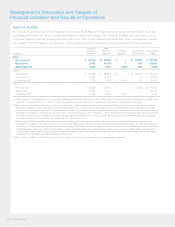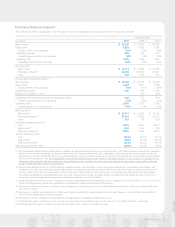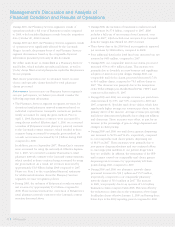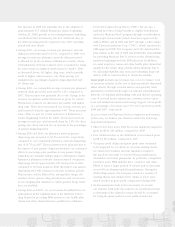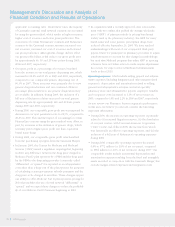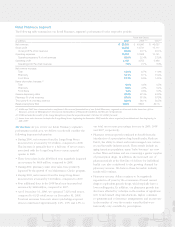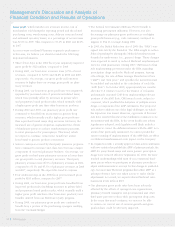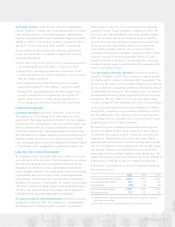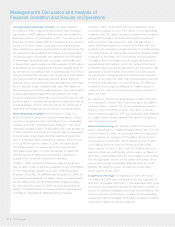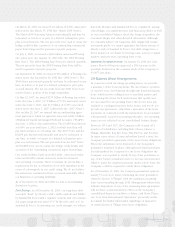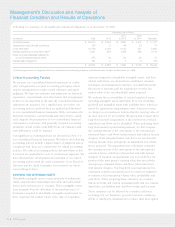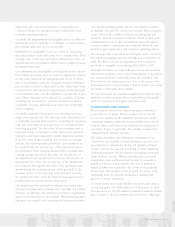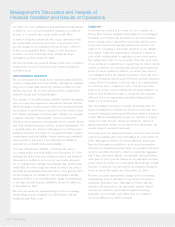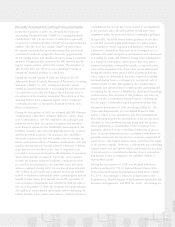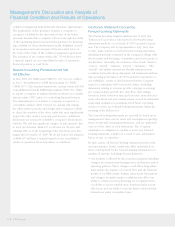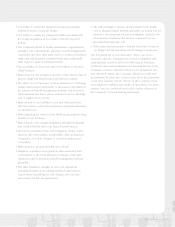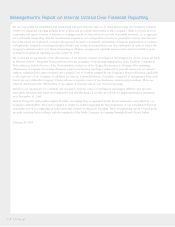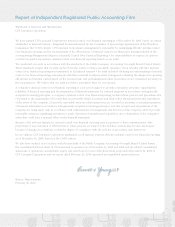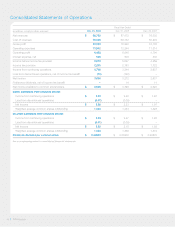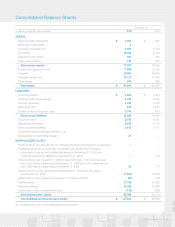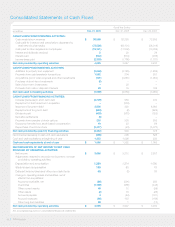CVS 2009 Annual Report Download - page 40
Download and view the complete annual report
Please find page 40 of the 2009 CVS annual report below. You can navigate through the pages in the report by either clicking on the pages listed below, or by using the keyword search tool below to find specific information within the annual report.
Management’s Discussion and Analysis of
Financial Condition and Results of Operations
Amounts assigned to identifiable intangible assets, and their
related useful lives, are derived from established valuation
techniques and management estimates. Goodwill represents
the excess of amounts paid for acquisitions over the fair
market value of the net identifiable assets acquired.
We evaluate the recoverability of certain long-lived assets,
including intangible assets with finite lives, but excluding
goodwill and intangible assets with indefinite lives, which are
tested for impairment using separate tests, whenever events
or changes in circumstances indicate that the carrying value of
an asset may not be recoverable. We group and evaluate these
long-lived assets for impairment at the lowest level at which
individual cash flows can be identified. When evaluating these
long-lived assets for potential impairment, we first compare
the carrying amount of the asset group to the asset group’s
estimated future cash flows (undiscounted and without interest
charges). If the estimated future cash flows are less than the
carrying amount of the asset group, an impairment loss calcula-
tion is prepared. The impairment loss calculation compares
the carrying amount of the asset group to the asset group’s
estimated future cash flows (discounted and with interest
charges). If required, an impairment loss is recorded for the
portion of the asset group’s carrying value that exceeds the
asset group’s estimated future cash flows (discounted and
with interest charges). Our long-lived asset impairment loss
calculation contains uncertainty since we must use judgment
to estimate each asset group’s future sales, profitability and
cash flows. When preparing these estimates, we consider
historical results and current operating trends and our consoli-
dated sales, profitability and cash flow results and forecasts.
These estimates can be affected by a number of factors
including, but not limited to, general economic conditions,
efforts of third-party organizations to reduce their prescription
Following is a summary of our significant contractual obligations as of December 31, 2009:
Payments Due by Period
2011 2013
in millions Total 2010 to 2012 to 2014 Thereafter
Operating leases $ 26,913 $ 2,094 $ 3,830 $ 3,512 $ 17,477
Leases from discontinued operations 150 5 48 23 74
Long-term debt 10,706 2,102 2,103 551 5,950
Interest payments on long-term debt (1) 7,307 559 1,058 980 4,710
Other long-term liabilities reflected in
our consolidated balance sheet 273 76 50 50 97
Capital lease obligations 154 2 7 9 136
$ 45,503 $ 4,838 $ 7,096 $ 5,125 $ 28,444
(1) Interest payments on long-term debt are calculated on outstanding balances and interest rates in effect on December 31, 2009.
Critical Accounting Policies
We prepare our consolidated financial statements in confor-
mity with generally accepted accounting principles, which
require management to make certain estimates and apply
judgment. We base our estimates and judgments on historical
experience, current trends and other factors that management
believes to be important at the time the consolidated financial
statements are prepared. On a regular basis, we review our
accounting policies and how they are applied and disclosed
in our consolidated financial statements. While we believe the
historical experience, current trends and other factors consid-
ered, support the preparation of our consolidated financial
statements in conformity with generally accepted accounting
principles, actual results could differ from our estimates, and
such differences could be material.
Our significant accounting policies are discussed in Note 1 to
our consolidated financial statements. We believe the following
accounting policies include a higher degree of judgment and/or
complexity and, thus, are considered to be critical accounting
policies. The critical accounting policies discussed later in this
document are applicable to each of our business segments. We
have discussed the development and selection of our critical
accounting policies with the Audit Committee of our Board of
Directors and the Audit Committee has reviewed our disclo-
sures relating to them.
GOODWILL AND INTANGIBLE ASSETS
Identifiable intangible assets consist primarily of trademarks,
client contracts and relationships, favorable and unfavorable
leases and covenants not to compete. These intangible assets
arise primarily from the allocation of the purchase price of
businesses acquired to identifiable intangible assets based on
their respective fair market values at the date of acquisition.
CVS Caremark
36


